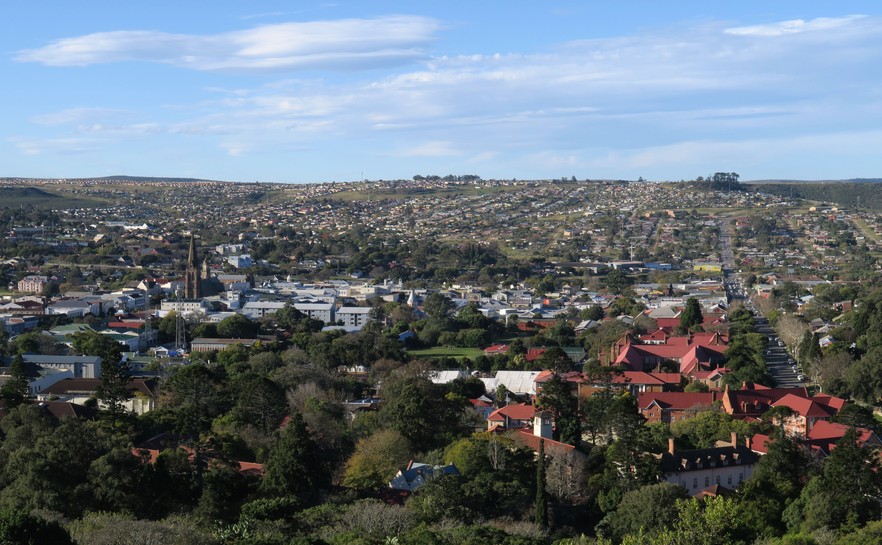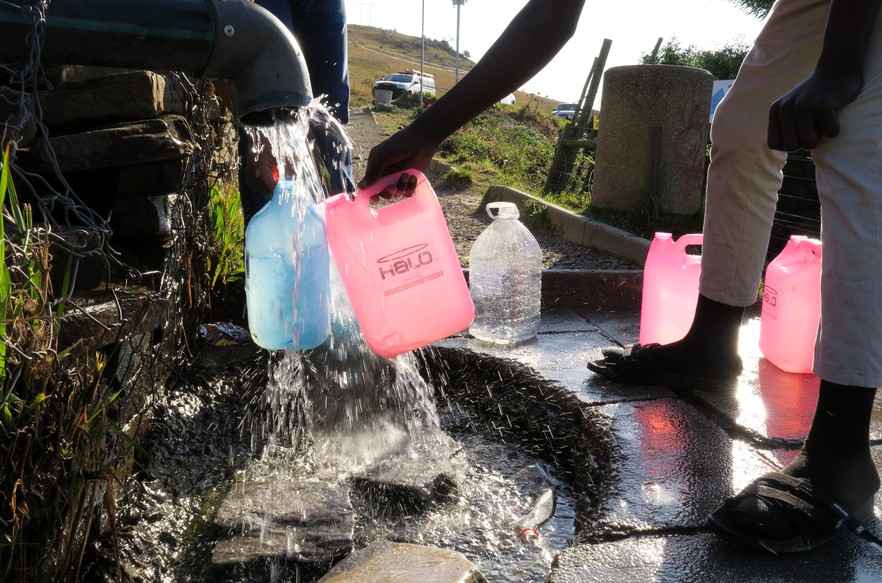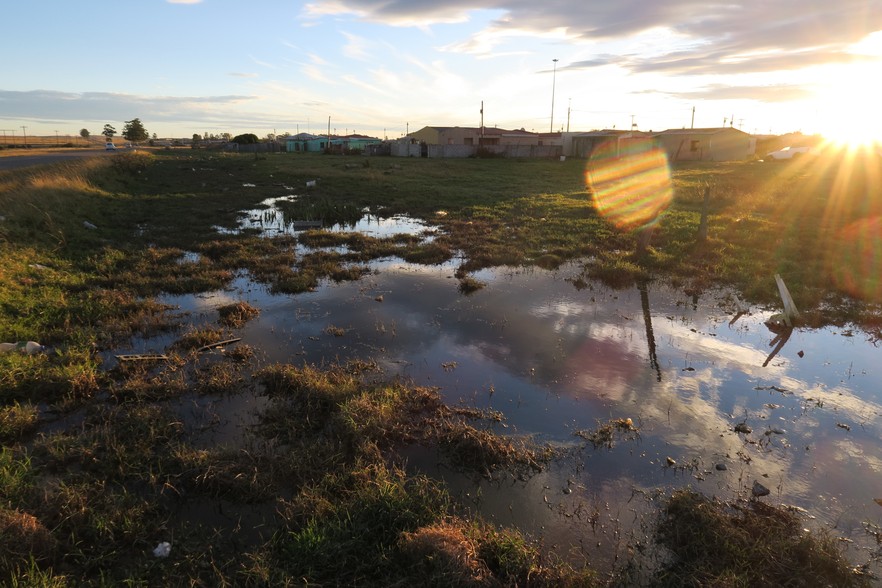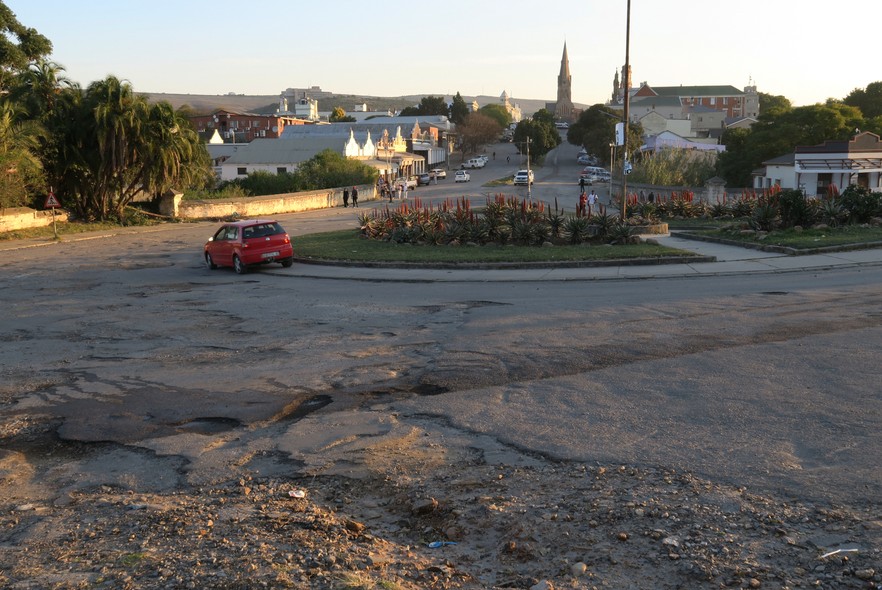Makhanda: The collapse of an iconic South African city
Roads, water supply, electricity supply and finances are in disarray
Historic Makhanda (formerly Grahamstown) is home to a university, prestigious private schools, the Eastern Cape High Court, and the annual National Arts Festival, yet its infrastructure is crumbling due to decades of mismanagement by the Makana Local Municipality. Photos: Steve Kretzmann
It was six days into the 51st annual National Arts Festival (NAF) in July this year, and yet there were no lights to welcome visitors entering the small city of Makhanda (formerly Grahamstown) after sunset.
Only the occasional shop front cast patches of light along High Street between Rhodes University’s Drostdy Arch and the landmark Anglican Cathedral. It was not a temporary power outage, but a situation that would persist for the rest of the 11-day festival. Municipal reports indicate this was mostly due to cable theft.
Historically, the main thoroughfares would be filled with buskers, traders, and festival-goers, but the dark streets were now almost deserted. A decade ago the festival attracted 225,000 people to watch more than 600 theatre shows. It’s now a fraction of that. (The municipality’s population is about 100,000.)
Usually the Makana Local Municipality makes an effort to temporarily patch up its failures over the festival period. Not this year.
Financial mismanagement
The municipality has received disclaimers of opinion from the Auditor General (AG) since the 2018/19 financial year. Prior to that, it had received qualified audits.
A disclaimer of opinion is the worst finding the AG makes. It occurs when the municipality’s finances are so mismanaged that the AG cannot provide documents to support its financial statements and therefore the AG cannot form an opinion.
After a crumbling reticulation system left residents and festival visitors without water for days on end in 2016, erstwhile festival CEO Tony Lankester publicly stated that the biggest threat to the festival’s continuation was not the paucity of arts funding, but the municipality itself.
Under a majority ANC council for at least 25 years, the city has steadily and visibly deteriorated. (This reporter lived there in the 1990s and has visited the city at least once a year for more than 20 years.)
Streets across the city are awash with potable water leaks and sewage overflows. Potholes are so prevalent that even some main streets are now little more than corrugated gravel. Water rationing and outages continue. Electricity outages are common. Municipal buildings are derelict from a lack of maintenance.
The festival has now shrunk to 242 shows, according to NAF spokesperson Sascha Polkey. Polkey did not supply visitor numbers, but patrons were visibly thin on the ground this year.
In 2013, the festival brought R349-million to the province (about R460-million today), including R90-million to the city’s coffers (about R159-million in today’s terms). Last year it brought in R132-million for the province, including R58-million for the city, according to a report by the South African Cultural Observatory.
Makhanda’s water reticulation system has so many leaks it led DA councillor Luvuyo Sizani to state that if there’s water running down your street it means there’s water in your tap.
Off grid
Residents have been experiencing water outages since at least 2012. Yet the municipality is still not able to ensure a continuous water supply to the whole town. This is despite supply dams being full.
The lack of a continuous and reliable water supply has forced large revenue-contributing institutions to seek independent supplies. This in the context of a municipality with a collection rate of less than 60%, according to opposition councillors.
Rhodes University, which has about 9,000 students at its Makhanda campus and is the single largest ratepayer, is moving to make itself independent of the municipality’s erratic water supply.
“A significant challenge facing the university is the unreliable water supply from the Makana municipality,” said deputy vice-chancellor Professor Mabokang Monnapula-Mapesela at an alumni event on 3 July.
“The university is progressing plans to establish its own water treatment facility to process water from its borehole system,” she said, calling on alumni to assist in funding the initiative.
The university communication office said it is also “exploring renewable energy solutions”.
Makhanda is home to three prestigious private schools. All have sought ways to provide a reliable water supply for their learners, staff and grounds.
Managers at the Diocesan School for Girls and Kingswood College said most of the water they now use comes from their own borehole and harvested rainwater. Only St. Andrew’s College still predominantly uses municipal water, relying on its own supplies during water outages.
Dry taps in the suburb of Tyantji may have contributed to 75-year-old resident Thandisizwe Nondlwana dying when his house burned down last month. Neighbours said they couldn’t douse the flames as their taps were dry. Firefighters arrived too late. A senior firefighter told GroundUp, on condition he was not named, that the roads are so bad that it is difficult to get to an emergency in time.
A spring on the outskirts of Makhanda is used by residents to obtain clean drinking water, as there has been insufficient water supply to the city since 2012, and concerns over the quality of the tap water when it is supplied.
Teetering systems
Makhanda uses about 18Ml (million litres) per day, municipal manager Phumelelo Kate said in May last year.
The water is supplied from the Waainek Water Treatment Works (WTW) on the west side of the city, and the James Kleynhans WTW on the east.
Retired water engineer Peter Sturrock estimates that the reticulation system has so many leaks that 28Ml needs to be pumped into the system per day for continuous, city-wide supply. As DA councillor Luvuyo Sizani put it: if you see the streets are wet, you know the water in that area is on; if the streets are dry, so are the taps.
An upgrade to the James Kleynhans Water Treatment Works, which abstracts water from the Glen Melville Dam on the Orange/Fish scheme, was announced as the solution to the city’s water troubles in 2015. It was meant to double the treatment works’ capacity from 10Ml to 20Ml per day by 2017. It is yet to be completed. The costs have ballooned from an initial R160-million to more than R700-million to date, according to Makana Citizens Front councillor Phillip Machanik.
Sturrock said the most it has ever supplied was 16Ml per day when three pumps were working full time. But the pumps burned out, and there is now only one operational pump at the James Kleynhans WTW.
Two rising mains – a pipeline through which water is pumped uphill – are required to deliver the 20Ml per day target. A second was built as part of the upgrade. But the original, which takes water up to the Botha’s Hill reservoir above the city, needs to be fixed. “Time and money ran out before that was done,” said Sturrock.
Although Amatola Water is in charge of the James Kleynhans upgrade, the municipality is supposed to exercise oversight and be responsible for operation and maintenance. The municipality reported to council that there is only one general worker at the treatment works when there are supposed to be six.
Water which seems to be leaking from an adjacent pump station forms a wetland alongside the road at the eastern entrance to Makhanda.
Drought and maintenance failures
In December, at the height of summer, the Howieson’s Poort dam, supplying the west side of town, came close to running dry. The system is designed so that when this happens, the dam can be topped up from the larger Settlers Dam, which lies in a different catchment and is fed by the Kariega River.
But, said Sturrock, when it was attempted, with just a few days of water left in Howieson’s Poort, valves along the pipeline burst. It had not been checked. The pipe and pump had not been used or maintained for years.
Disaster was averted when good rains filled Howieson’s Poort again. However, the pipeline and valves have not been fixed, so the same problem would occur if there is another dry spell of three or four months without rain.
Missing pump
The 8Ml per day Waainek Water Treatment Works (WTW), which abstracts water from Howieson’s Poort Dam, is working at full capacity. But municipal reports before council show it only has one operational pump, running day and night with no backup. Sturrock says there should be three: two pumps working on rotation, and a third for when one of the pumps needs servicing or repairs.
There is a second pump, but as reported at the municipality’s infrastructural development portfolio committee meeting of 10 July, it is “on limp mode” and requires repair.
A pump worth R2.7-million was ordered from Manco Business Enterprise in East London in July 2022, and paid for, but it has never been delivered.
The engineering and infrastructure director Asanda Gidana was dismissed in November 2023. One of the two charges was for unlawfully facilitating its pre-payment.
Gidana disputed her dismissal at the Bargaining Council, which ruled in her favour on both counts, and ordered she be paid six-months salary, amounting to R635,000, as she did not want her job back at the municipality. It appears Gidana was an innocent scapegoat, as the chief financial officer, the municipal manager and other municipal employees recommended and signed that the payment should be made.
The commissioner making the award, Mandlenkosi Mini, remarked, “One can draw an inference that it was common practice at the [municipality] that recommendations are made without due diligence being done.”
With neither the pump nor its installation and connection delivered, nor any money recovered, Makana Citizens Front councillor and party leader Lungile Mxube laid a charge of fraud and corruption against the mayor, municipal manager, chief financial officer and council speaker at the Makhanda police station on 20 June.
The municipality did not respond to questions on this and other issues.
There are so many potholes at the traffic circle at the end of Makhanda’s High Street that some drivers use the pavement. This mirrors the state of many of the city’s streets.
Support independent journalism
Donate using Payfast

Don't miss out on the latest news
We respect your privacy, and promise we won't spam you.
Letters
Dear Editor
Is it possible for the rate payers to be given access to all municipal tenders, revealing the identity of all signatories of all the tenders?
All water delivery vehicles must be owned by the municipality, not private individuals.
Who is responsible for verifying the qualifications as well as issuing tenders?
© 2025 GroundUp. This article is licensed under a Creative Commons Attribution-NoDerivatives 4.0 International License.
You may republish this article, so long as you credit the authors and GroundUp, and do not change the text. Please include a link back to the original article.
We put an invisible pixel in the article so that we can count traffic to republishers. All analytics tools are solely on our servers. We do not give our logs to any third party. Logs are deleted after two weeks. We do not use any IP address identifying information except to count regional traffic. We are solely interested in counting hits, not tracking users. If you republish, please do not delete the invisible pixel.





